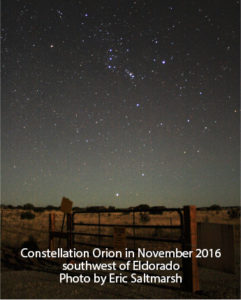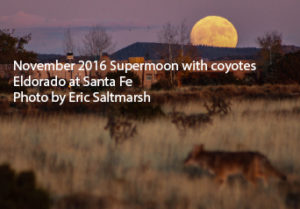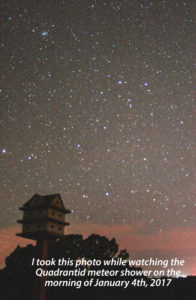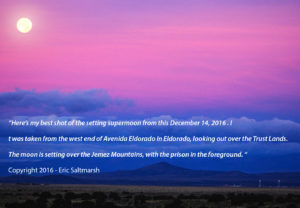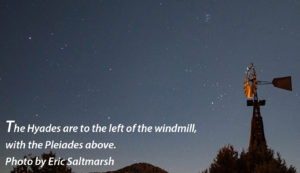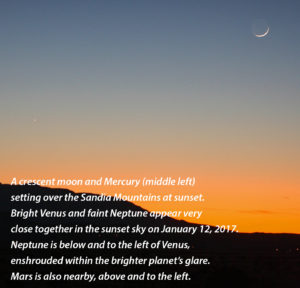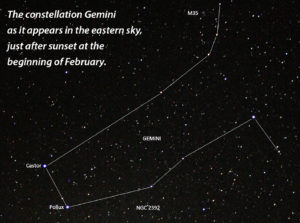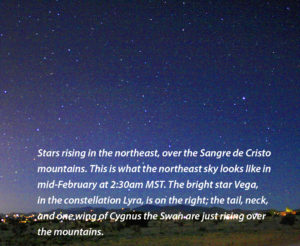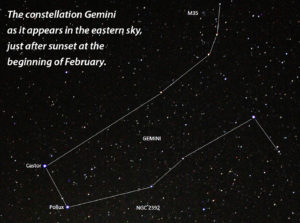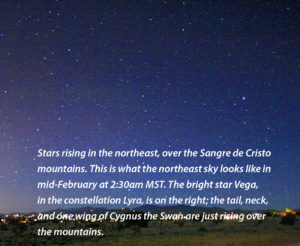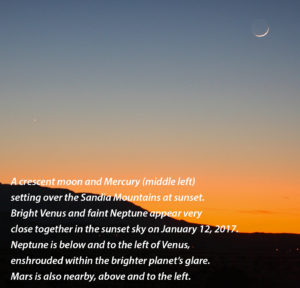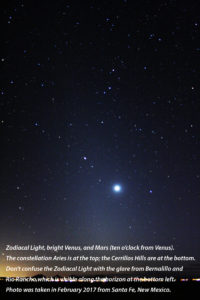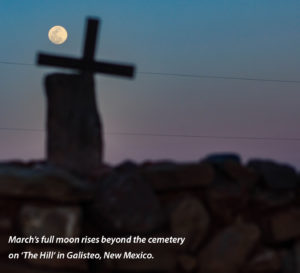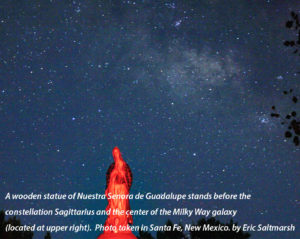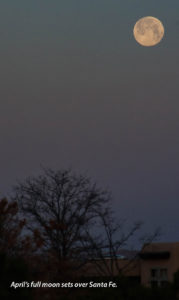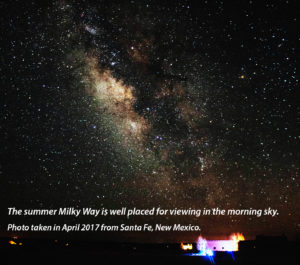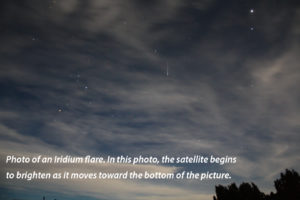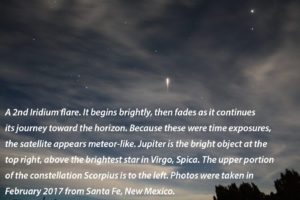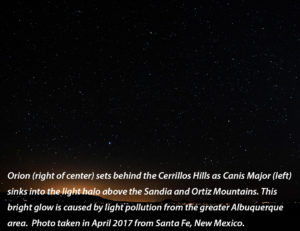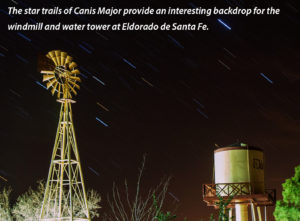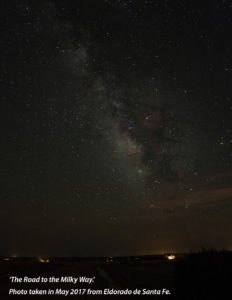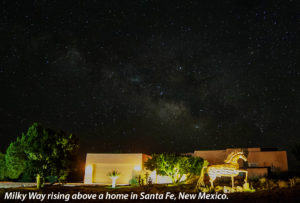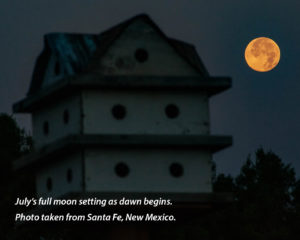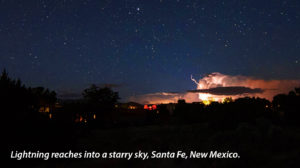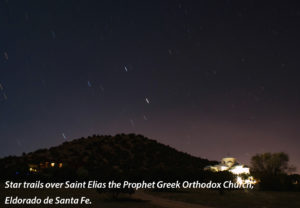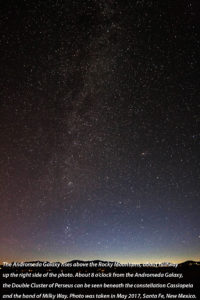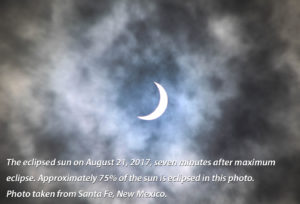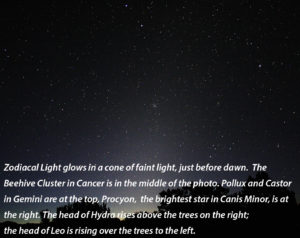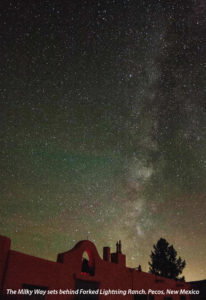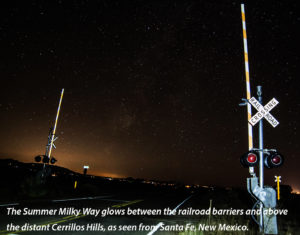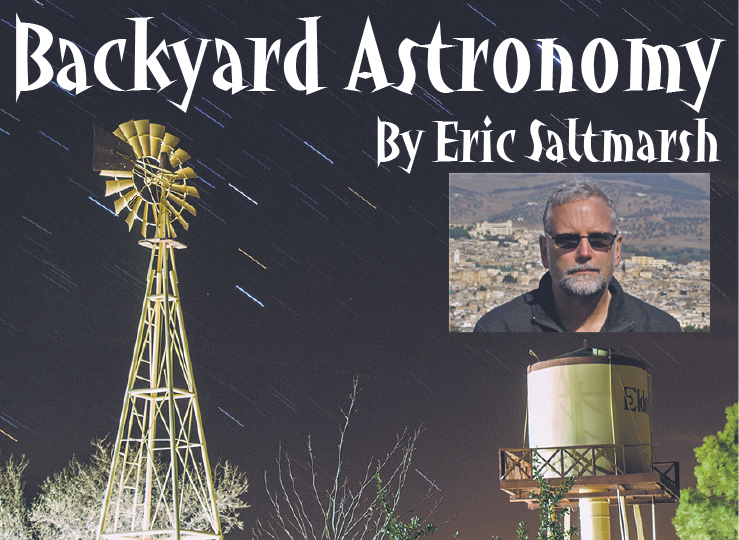
- December 2016
- January 2017
- February 2017
- March 2017
- April 2017
- May 2017
- June 2017
- July 2017
- August / September 2017
- October / November 2017
- December 2017 - January 2018
New Mexico’s Winter Stars Dazzle.
December and January are known for their long, chilly nights and starry skies. There are more bright stars at this time of year because we’re facing away from the center of our galaxy, instead, peering into the spiral arm of the Milky Way that our solar system inhabits. Therefore, many of the winter stars are closer to us and, hence, brighter than stars seen in other seasons.
If you go out on a clear, moonless evening this winter, you’ll see the Milky Way span the sky from the Northern Cross standing upright above the WNW horizon, up through Cassiopeia and Perseus, then down into Taurus, Orion, and, finally, Canis Major. The constellation Canis Major (Big Dog) contains Sirius, the brightest star in the sky other than the sun. Sirius rises like a blue-white diamond in the ESE about 8pm at year’s end.
December marks the annual return of the Geminid meteor shower, one of the most active showers of the year. Unfortunately, the shower peak on the night of December 13-14 coincides with the full moon, so faint meteors will be rendered invisible. This moon will be a ‘supermoon,’ a full moon occurring when it’s closest to Earth in its slightly elliptical orbit, making it appear a little larger than normal. However, only a photographic comparison with non-supermoons will bear this out.
The winter solstice, representing the longest night of the year, occurs on December 21. Wiccans and pagans celebrated this occasion as ‘Yule,’ a time in which darkness relinquishes its power to the growing light of day. On this first day of winter, the Earth’s 23.5 degree tilt is oriented in such a way that the northern hemisphere is farthest away from the sun, making the sun appear to be at its lowest point in our sky.
Venus graces the southwestern sky after sunset, shining like the Christmas Star. As you probably know, the Christmas Star, also known as the Star of Bethlehem, was a light in the sky that led the three Magi to Jesus’ house. Some say they followed a comet, others suggest that they saw a close grouping of bright planets or an exploding star, called a nova. While nobody knows what the three Wisemen supposedly saw, splendid Venus offers a good facsimile after sunset on Christmas Eve.
January opens with another meteor shower, the Quadrantids. The Quadrantids are named for a faint constellation near the end of the Big Dipper’s handle, known as Quadrans Muralis. This constellation is no longer recognized, now considered part of the constellation Bootes, but the meteor shower continues to bear the old name.
The shower peaks on the night of January 3-4 with about 40 meteors per hour visible. However, the shower could increase to 100 or so meteors an hour for a brief period of time. Since the moon will be in the waxing crescent phase, it won’t interfere with viewing. The best time to watch for Quadrantid meteors is between midnight and dawn on January 4.
Here is a summary of interesting night sky events in December and January:
December 11:
The planet Mercury is visible for a few days before and after this date, low in the southwest, just after sunset.
December 13-14:
The Geminid meteor shower peaks on this night.
December 14:
The night of the Full Cold Moon, named by Native Americans for the frigid night temperatures.
December 21:
Winter solstice occurs — the first day of winter and longest night of the year.
January 1-5:
The Quadrantid meteor shower peaks on the night of January 3-4.
January 12:
The night of the full Wolf Moon.
January 19:
For a few days around this date, speedy Mercury can now be seen low in the east at dawn.
January 31:
Venus, Mars, and the crescent moon make a nice grouping in the southwest, after sunset.
JANUARY’S NIGHT SKY
The evening of January 12 offers an interesting spectacle for anybody possessing binoculars or a small telescope. On this evening, the planets Venus and Neptune will be separated by only 0.2 degrees when they reach ‘conjunction’ with one another. Our next door neighbor, Venus, is the brilliant white object in the southwestern sky, while distant Neptune will be the pale bluish ‘star’ nearby, just beyond naked eye visibility. Look at them with optical aid just after sunset. The pair will set around 9pm MST.
While Venus appears to be the brighter of the two planets by far, Neptune’s diameter is four times that of Venus. It’s Venus’ proximity to both Earth and Sun, along with the reflectiveness of its cloud tops, that allow it to significantly outshine Neptune, which is 42 times more distant from the sun. While the two planets appear close together on the 12th, they are actually 2.7 billion miles apart.
You might watch for a couple of days before and after the 12th, to observe how quickly Venus appears to approach and pass distant Neptune.
By the end of January, the zodiacal constellation Taurus will be almost overhead at 8pm MST. The constellation has two distinctive features, easily seen with the naked eye.
First, note the V-shaped cluster of stars with the bright orange star at one end, representing the bull’s face. The ‘V’ is the closest open cluster (stars born in the same cloud of gas and traveling together through space) to our solar system. It’s known as the Hyades, named for the daughters of Atlas, a titan in Greek mythology. The bright orange star, Aldebaran, is not part of the Hyades cluster.
Above and to the right of the Hyades, you’ll see a small dipper of stars. This is another open cluster close to us, known as the Pleiades, located in the bull’s shoulder. The Zuni people of western New Mexico see this tight cluster as ‘seed stars’ because the Pleiades’ disappearance behind the sun in the spring coincides with the planting season.
The Ancient Greeks knew the Pleiades as the Seven Sisters – also daughters of Atlas and, therefore, sisters of the Hyades. Most people today can only see six ‘sisters’ without optical aid. Some say they can see ten or more stars under ideal seeing conditions. There are actually about 500 stars in the cluster.
Here is a summary of interesting night sky events in January:
January 1-5: The Quadrantid meteor shower peaks on the night of January 3-4.
January 11-12: The night of the full Wolf Moon. For New Mexican viewers, the moon is officially full at 4:34am MST on January 12.
January 12: Venus and Neptune are in conjunction in the southwestern sky after sunset, in the constellation Aquarius.
January 19: For a few days around this date, speedy Mercury can be seen low in the east, at dawn.
January 31: Venus, Mars, and the crescent moon make a nice grouping in the southwest, after sunset.
FEBRUARY’S NIGHT SKY
February 2017 opens with the crescent moon, Mars, and Venus in a line above the WSW horizon at 7pm MST on the 1st, all in the faint constellation Pisces. The bright constellations of Taurus, Auriga, and Gemini are high in the sky in the SSE, while trailing Orion and Canis Major are closer to the horizon in the SE. The head of Leo the Lion is rising above the ENE horizon, looking like a reverse question mark.
By mid-month, the constellation Gemini is high overhead at 9pm MST. One of the constellations of the zodiac, Gemini is situated between Taurus and Cancer (Note: the zodiac is the group of 13 constellations that the sun appears to travel through, as the Earth orbits it during the course of a year – in case you’re wondering, the 13th zodiacal constellation is Ophiuchus).
Gemini rises just after sunset at the winter solstice and is lost in the solar glare at the summer solstice. Because the Earth slowly wobbles on its axis over a period of 25,000 years, the solstice points slowly migrate from one constellation to another. The summer solstice point resided in Gemini for almost two millenniums before crossing into Taurus in 1989.
The ancient Babylonians knew the two brightest stars in the constellation Gemini as ‘the Great Twins.’ They were considered minor gods associated with the underworld.
More ‘recent’ Greek mythology saw the constellation as a representation of Pollux and Castor, twin sons of their earthly mother, Leda. While the twins were conceived on the same night, the Greek god Zeus was the father of immortal Pollux; Tyndareus, the king of Sparta and Leda’s husband, was the father of mortal Castor.
Despite their very different fathers, the twin half-brothers were quite close. When Castor died, crestfallen Pollux asked his father to use his godly powers to reunite the brothers. As a result, the two brothers were set in the sky, where they would remain together forever.
The two brightest stars in Gemini are named for the heavenly brothers of Greek mythology. Pollux, an orange giant star, is slightly brighter than blue-white Castor.
While Castor looks like a single star to the unaided eye, it’s actually a star system consisting of six stars — three pairs of double stars all orbiting around a common center of gravity. Imagine what life would be like on a planet revolving around one of those six, gravitationally-related stars.
The easiest deep sky object to find in Gemini is Messier 35 (M-35), a loose cluster of about 200 stars that covers an expanse of sky approximately equal to that of a full moon. This asterism appears as a small, fuzzy ‘star,’ just visible to the unaided eye, near the northernmost foot of Gemini. Binoculars or a small telescope is all that’s needed to resolve this fuzzy star into a striking sprinkle of stardust.
A more challenging deep sky object to observe is the Eskimo Nebula (NGC 2392), so named because the nebula resembles a face surrounded by a fur hood. Detailed observation of this remnant of an exploding star requires a medium-sized telescope. Telescopes of four to eight inches can reveal the ‘face,’ which is really a gaseous bubble surrounding a central star, and the ‘hood,’ which is gas, shot through with spokes of lighter-colored material.
Here is a summary of interesting night sky events occurring in February 2017:
February 5: The bright orange star Aldebaran is a mere 0.2 degrees south of waxing gibbous moon at 2:14pm MST. Look for this pair, still close together, as dusk deepens on this evening.
February 10: The ‘Snow Moon’ (also called the ‘Hunger Moon’) is full at 5:33pm MST. Moonrise is at 5:39pm MST, so the moon will be virtually full when it comes up. There is a penumbral lunar eclipse (sunlight passing through Earth’s atmosphere, being dimmed before hitting the moon – not easily observed) associated with this full moon, but it will not be visible from New Mexico.
February 11: Comet 45P Honda-Mrkos-Pajdusakova passes Earth at a distance of eight million miles. While at the limit of naked eye viewing, light from the just past full moon will require binoculars or a telescope to see it in the morning sky. The comet will be high in the SE sky before dawn begins, in the constellation Corona Borealis, near the border with Hercules.
February 11: The brightest star in the constellation Leo, Regulus, is 0.8 degrees north of the waning, gibbous moon at 7:04am MST. Since the sun rises at 6:54am, look for this close pair in the west before dawn interferes.
February 26: New moon. A total annular solar eclipse (an eclipse in which the moon’s disk is slightly smaller than the sun’s, leaving a thin ring of sunlight around the moon at totality) will occur, but it won’t be visible from New Mexico.
THE NIGHT SKY IN MARCH
March skies are characterized by the disappearance of autumn constellations in the west and the emergence of spring constellations in the east. As the month opens, Venus and Mars are close together in the WSW after sunset. Mercury and the crescent moon are closer to the horizon – all four objects are in the constellation Pisces.
By mid-month, Cancer is almost directly overhead at 9pm MST. Cancer is a mid-sized, relatively faint constellation, sandwiched between Gemini and Leo. When viewed high in the sky, the constellation looks like a divining rod or an upside down ‘Y’.
Cancer the crab is one of those constellations in which you really have to stretch your imagination to see its likeness in the star pattern. Today’s constellation has its roots in Greek mythology, whereby a crab bit Hercules (a.k.a., Heracles) on the foot while he was fighting the multi-headed monster, the Lernaean Hydra. One version of the myth has Hercules flicking the annoying crustacean into the sky.
In another version, the goddess Hera, who set the crab on Hercules to distract him in his fight with the serpent-like monster, placed the crab in the stars after Hercules stomped on it. Incidentally, Hera placed the head of Hydra directly beneath the crab in the sky.
Another Greek myth tells a very different tale of Cancer. According to mythologist Mike Belmont, Mount Olympus was threatened by a monster, Typhon, sending the gods into hiding. Before departing to safety, Poseidon, god of the sea, tasked a giant crab, Crios, with guarding his sea nymphs.
Several of the nymphs escaped to the open sea, where they were eaten by a villainous squid named Vamari. Crios subsequently fought Vamari and eventually won, despite developing serious wounds. Poseidon rewarded Crios for his valor by placing him in the heavens as the constellation Cancer.
In ancient Babylonia, now part of Iraq, the constellation Cancer was associated with the Gate of Men, the place in the sky where souls re-entered human bodies and returned to Earth.
The Chinese had a different approach to mapping the stars. In ancient Chinese astronomy, developed independently of the Babylonians and the Greeks, Romans, and Arabs of the Mediterranean area, the sky was divided into four quarters. The quarter of the sky that included Cancer was known as the Vermillion Bird of the South. The Chinese also divided the sky into 28 mansions, similar to the zodiac and used as a sort of lunar calendar. The mansion that contained Cancer was called Ghost. The Japanese, Koreans, and other Southeast Asia cultures followed the Chinese convention of dividing the sky.
The most interesting feature in the constellation Cancer is the open cluster Messier 44 (M44), also known as Praesepe or the Beehive Cluster. Against dark skies, this cluster can be seen with the unaided eye as a faint patch of light, but minor optical aid will resolve the patch into myriad stars. Interestingly, the ancient Chinese referred to this fuzzy patch of light as ‘Tseih She Ke.’ This translates into English as the ‘Exhalation of Piled Up Corpses.’
Here is a summary of interesting night sky events occurring in March 2017:
March 12: Full moon. The Zuni people refer to this moon as ‘li-dekwakkya ts’ana’ or the ‘Little Sand Storm Moon’ since the spring winds are beginning to blow across the desert lands.
March 20: The vernal equinox occurs at 3:29am MST, when the sun is directly over the equator. It marks the first day of spring in the northern hemisphere.
March 27: New moon. The week around the time of the new moon is the best opportunity to view faint objects in the night sky, such as galaxies and interstellar clouds of gas called ‘nebulae,’ without the interference of moonlight.
Month of March: The Zodiacal Light is visible in the western evening sky, for up to an hour after dark. The Zodiacal Light is a faint cone of light that can be seen under dark, moonless lights, free of light pollution. The phenomenon is the result of sunlight from below the horizon hitting interplanetary dust particles that orbit the sun. It’s best seen just after dark from late February to early May and before dawn in the early fall.
APRIL’S NIGHT SKY
While Mercury and Mars fade from prominence in April, Jupiter is moving into prime-time position. Jupiter reaches opposition (its closest approach to Earth) on April 7, when it will be visible from sunset to sunrise. At its closest distance to Earth (411 million miles away), it takes light reflecting off Jupiter’s cloud tops 36 minutes to reach our eyes.
The planet sits in the constellation Virgo, not far from the bright star Spica. At magnitude -2.5, Jupiter is the brightest object in the night sky, excepting the Moon.
Jupiter is the largest planet in our solar system. It’s so big, you could fit more than 1,300 Earths inside it.
Jupiter is covered by a thick atmosphere. Its rotation period of just under ten hours (versus the Earth’s 24-hour rotation) gives the cloud-covered planet a pronounced oval shape, when seen through a telescope. This fast rotation distributes the clouds in bands that stripe the planet.
The planet has four faint rings and 67 moons that orbit it. While many of these moons are small, four of them are so large and bright that they can be seen with even a modest telescope. In fact, one moon, Ganymede, is the largest moon in the solar system – it’s bigger than the planet Mercury.
April is the month of the Lyrid meteor shower. The shower occurs from approximately April 16 to April 25, with the peak occurring the night of April 22-23. During normal peak periods, about 10-20 meteors per hour might be seen. The best time to watch is after midnight.
Here is a summary of interesting night sky events occurring in April and early May 2017:
April 1-30: The Zodiacal Light, a faint, cone-shaped glow occurring in dark skies, can be found in the west, immediately after dusk. The glow is caused by sunlight from below the horizon striking interplanetary dust particles in orbit around the sun.
April 1: The planet Mercury, on the Pisces-Aries border, is at greatest eastern elongation (its highest point above the western horizon), setting about an hour and a half after the sun. Also, notice the close pairing of the crescent moon and the bright red star Aldebaran, which marks the eye of Taurus the Bull.
April 7: Jupiter at opposition, rising in the east at sunset.
April 10-11: Full Moon at 12:08am MDT on the 11th.
April 19-21: Low in the WNW just after sunset, Mars passes to the south of the Pleiades star cluster.
April 22-23: Lyrid meteor shower peaks.
April 26: New Moon. Since the moon is near the sun in the sky, the skies will be exceptionally dark for several nights around this date.
May 1-28: The Eta Aquarid meteor shower occurs throughout May. The shower peaks on the mornings of May 5 and 6. It’s best viewed in the pre-dawn hours when 40-60 meteors may be seen.
May 10: Full moon occurs at 3:43pm MDT. Here is a summary of interplanetary dust particles in orbit around the sun.
MAY’S NIGHT SKY
This month, the constellation Leo is well-situated for early evening viewing, located high in the south as the sky darkens. Bright Jupiter is in the southeast at dusk.
Leo the Lion is one of the constellations that really looks like the object it represents. Look for the large, reverse question mark or sickle, with the bright star Regulus at the bottom. This asterism marks the lion’s head and mane. To the east (left) is a large triangle which marks the lion’s hindquarters.
Since Leo lies opposite the Milky Way, we are able to see in this constellation numerous galaxies beyond our own. Most of these galaxies require viewing with large telescopes, with long photographic exposures needed to show much detail.
You may notice a faint sprinkling of stars, slightly above and to the left of Leo’s hindquarters. These are the stars of Coma Berenices (a.k.a., Berenice’s Hair, named in honor of a historical queen of Egypt). A small, faint constellation, Coma Berenices is quite pleasing to observe when the sky is clear and dark. At such times, more than four dozen faint stars can be seen, like a scattering of sand. Like its neighbors, Leo and Virgo, Coma Berenices is home to a rich cluster of distant galaxies.
Want something different? Try spotting an ‘Iridium flare.’ There are over 60 Iridium communication satellites orbiting almost 500 miles above the Earth. When sunlight strikes their door-sized antennas, the light is reflected down to Earth. If you look in the right part of the sky at the right time, you’ll see a slow-moving ‘star’ brighten, then fade, all in a matter of a few seconds. Sometimes an Iridium flare can momentarily become the brightest object in the night sky.
The following website is a great resource for predicting Iridium flares, International Space Station passages, and other events happening above our heads:
===
Here is a summary of interesting night sky events occurring in May and early June 2017:
May 1-3: Mars passes north of the star cluster known as the Hyades in Taurus.
May 1-28: The Eta Aquarid meteor shower occurs throughout May. The shower peaks on the mornings of May 5 and 6 and is best viewed in the pre-dawn hours when 40-60 meteors may be seen.
May 10: Full moon occurs at 3:43pm MDT.
May 17: Mercury is at greatest western elongation from the sun, best placed for viewing in the dawn sky, just above the eastern horizon.
May 25: New moon occurs at 1:46pm MDT.
June 3: Venus is at greatest western elongation, well above the east horizon in the pre-dawn sky.
June 9: Full moon occurs at 6:10am MDT.
JUNE’S NIGHT SKY
This month, the constellation Virgo, the second-largest constellation, spans the meridian at dusk. Its brightest star, Spica, is below and to the left of bright Jupiter. Spica forms the base of a large ‘Y’, the arms of which are just above and slightly to the right of Jupiter’s current position. It also marks the lower right corner of a large rectangle running east.
Virgo is home to myriad distant galaxies, many of which can be found within the arms of the above-mentioned ‘Y.’ Medium to large telescopes and long-exposure photographs are needed to reveal galactic details.
The ancient Babylonians saw the constellation Virgo as an ear of grain belonging to Shala, the goddess of grain. Shala was married to the fertility god, Dagon.
To the later Greeks and Romans, Virgo represented the goddess of agriculture (Demeter to the Greeks; Ceres to the Romans). The goddess is often depicted on star maps holding a sheaf of wheat in each hand. Despite the ‘virgin’ characterization connected with the constellation (likely due to Astraea, the Greek goddess of innocence who is more closely associated with neighboring constellation Libra), Virgo is mainly associated with the growing of crops and fertility.
The Summer Milky Way is moving into prime viewing. At mid-month, it will be visible, low in the southeast just after dark, in the constellations Scorpius and Sagittarius. Follow the cloud of stars as it flows eastward through Aquila and Cygnus, on into Cassiopeia, low in the NNE.
Also at midmonth, the planet Saturn, in the ESE at sunset, is directly opposite the sun and at its closest distance to Earth. The famed ringed planet appears as a bright yellow ‘star’ in the constellation Ophiuchus, close to the Sagittarius border.
Like all planets beyond the orbit of Mars, Saturn is a gaseous giant, swathed in a dense atmosphere of hydrogen and helium. Orbiting Saturn are 62 moons, only one of which has a diameter greater than Earth’s moon. Titan, Saturn’s largest moon, is the only known moon to be cloaked in a thick atmosphere.
However, the attribute that makes Saturn such a beloved object is the system of rings that encircle its equator. Mainly composed of ice, the rings are approximately 70,000 miles wide, but only about 60 feet thick. The origin of the rings remains unknown, although theories include 1) material left over from the formation of the planet was swept into a flat disk and 2) a moon that was ripped apart, through collision or by tidal forces.
===
Here is a summary of interesting night sky events occurring in June and early July 2017:
June 3: Venus is at greatest western elongation, above the east horizon in the pre-dawn sky.
June 9: Full moon at 6:10am MDT.
June 15: Saturn reaches opposition and is visible all night.
June 20: Summer solstice occurs in the northern hemisphere at 9:24pm MDT when the sun reaches its most northern point in the sky.
June 23: New moon at 7:31pm MDT.
July 8: Full moon occurs at 9:07pm MDT.
JULY’S NIGHT SKY
As July opens and we say goodbye to Leo in the west, my favorite part of the sky becomes visible just after dark. The constellation Scorpius, with the bright red star Antares marking the scorpion’s heart, stands upon its tail above the southern horizon. Neighboring Sagittarius, resembling a teapot, is newly risen, to the left of Scorpius’ tail, in the SSE.
If the sky is dark and clear and you wait until the moon sets, you’ll be treated to a stunning view of our galaxy, the Milky Way. Be sure that your eyes are adapted to the dark, so you can make out the finer aspects of our galaxy.
The Milky Way begins at our southern horizon and angles up into the northeast. It flows like a ghostly stream, starting in Scorpius and passing through Sagittarius, Aquila, Cygnus, Cassiopeia, and finally Perseus in the northeast.
On a clear night under dark skies, you can make out interesting details within the Milky Way, even without optical aid. Taken as a whole, you can make out light and dark lanes within the Milky Way. The light, cloud-like areas are myriad stars within our galaxy; the dark lanes are clouds of gas and dust that obscure the light of the stars behind them. If you could see the center of our galaxy (it’s hidden by clouds of gas and dust), you would find it in the constellation Sagittarius, just above and to the right of the ‘tea spout.’
Looking more closely, you can see clusters of stars as well as several nebulae – clouds of gas in which stars are being born. And if that’s not enough, the planet Saturn is currently traversing the Milky Way near the Ophiuchus – Sagittarius border.
We New Mexicans are so fortunate to have beautiful, unpolluted skies around us, so we can see our galaxy in all its glory. Our only challenge, other than a moonlit night, is the start of the southwest monsoon season, which will bring thunderstorms to our skies on many a summer night.
As a reminder, please keep your exterior lights pointed down and don’t turn on more lights than you need in order to preserve our dark, pristine New Mexican skies. Every little bit helps.
Here is a summary of interesting night sky events occurring in July and early August 2017:
July 1: Between sunset on June 30 and 1am MDT on July 1, Jupiter will be visible within three degrees of the first quarter moon.
July 8: Full moon occurs at 10:07pm MDT. Native Americans call this moon the Full Buck Moon because bucks begin their antler growth. It’s also known as the Thunder Moon which, in New Mexico, is quite appropriate.
July 23: New moon.
July 29: The Delta Aquarid meteor shower peaks on the night of 29th and morning of 30th. Approximately 20 meteors per hour can be expected, once the first quarter moon sets, just after midnight.
July 30: Mercury is at greatest eastern elongation, briefly visible after sunset, in Leo.
August 7: Full moon occurs at 12:11pm MDT. There’s a partial eclipse of the moon at this time, but since the moon won’t rise in New Mexico until around 7:30pm MDT, it won’t be visible in this part of the world.
August 11: The Perseid meteor shower peaks on the night of the 11th and morning of the 12th. Sixty or more meteors per hour can be expected under ideal conditions, but unfortunately, the waning gibbous moon will rise around 10:30pm MDT, hampering the viewing of fainter meteors during the remainder of the night.
AUGUST AND SEPTEMBER’S NIGHT SKY
Seeing the stars of August and September from Northern New Mexico can be a challenge since clouds of the southwest monsoon often interfere. But patience will be rewarded with occasional views of the summer Milky Way, which is in prime viewing position when darkness falls. From the SSW horizon to the NNE one, the Milky Way splits the sky with its starry glow.
To me, the Milky Way also serves as a sort of cosmic wall, separating the brighter, more numerous stars of summer on the west side of the wall and embedded within it from the fainter autumn constellations coming into view in the east.
August brings us one of the most anticipated astronomical events of the year, the Perseid meteor shower. During ideal conditions, we can expect to see 60+ meteors per hour during the shower’s peak on the night of August 11th and the morning of August 12th. Unfortunately, the moon is just past full at this time and will partially interfere with viewing.
On August 21st, we’ll be treated to a partial solar eclipse. From Santa Fe, the eclipse begins at 10:22am MDT. Maximum eclipse occurs at 11:46am MDT, at which time the moon will cover 76% of the sun’s disk (from Albuquerque, 73% of the sun will be obscured). The eclipse ends at 1:15pm MDT. Please note that from Albuquerque, the eclipse will begin and end about a minute earlier than the times shown for Santa Fe. Unfortunately, the closest place on the path of the totality is about 650 miles to our north, in central Wyoming.
As we approach the autumnal equinox, we must say goodbye to Jupiter, which has graced our evening skies since spring. Jupiter disappears in the west, just after sunset, and by the end of September, is almost lost in the glare of the recently set sun. This leaves Saturn, low in the SSW at dusk, as the only naked eye planet visible until brilliant Venus rises, just after 4am.
Speaking of the autumnal equinox, the sun appears directly above the Earth’s equator on September 22nd at 2:02pm MDT. Contrary to popular belief, day and night are technically not of equal duration on this day.
According to the Old Farmer’s Almanac (one of my favorite sources of arcane information), the reason is because daytime begins when the top of the sun appears above the eastern horizon and ends when the sun’s disk completely disappears in the west. As a result, daytime is a tad longer than nighttime on the first day of autumn. If the sun were a point like any other star (or if daytime was measured based on when the center of the sun’s disk hits the eastern and western horizons), then daytime and nighttime would be equal.
Here is a summary of interesting night sky events occurring in August and September 2017:
August 7: Full moon occurs at 12:11pm MDT.
August 11: The Perseid meteor shower peaks on the night of the 11th and morning of the 12th. Sixty or more meteors per hour can be expected under ideal conditions, but the waning gibbous moon will rise around 10:30pm MDT, hampering the viewing of fainter meteors.
August 21: A partial solar eclipse is visible, beginning at approximately 10:22am MDT. At maximum eclipse, approximately 75% of the sun will be covered by the moon.
September 6: Full moon at 1:03 am MDT.
September 12: Mercury is at greatest western elongation from the sun, visible low in the east at dawn, close to Mars and not far from brilliant Venus.
September 22: Autumn begins in the northern hemisphere.
OCTOBER AND NOVEMBER’S NIGHT SKY
As we move into autumn, the end of the monsoon season returns to us our starry skies. While the autumn constellations are not brilliant, we can still enjoy the summer constellations and the summer Milky Way setting in the west and anticipate the bright winter stars rising later in the night.
However, the autumn constellations are more than just a bridge from summer to winter skies. They offer plenty of interesting patterns and objects for those willing to look closely.
Start with the Great Square of Pegasus, a giant rectangle that dominates the autumn sky, located high in the southeast at 10pm MDT on October 1 and 8pm MDT on November 1. Pegasus is the winged horse of Greek mythology.
Emanating from the top left star in the Great Square, Sirrah, is a tail-like constellation held high above the Square. This long, narrow ‘V’ is the constellation Andromeda. Each side of the V is comprised of three stars, in addition to Sirrah at the base.
On each side of the V, count up two stars from Sirrah. A line connecting these two stars and extending a similar distance to the upper right brings you to a fuzzy, oval star. This is the Andromeda Galaxy, one of our closest galactic neighbors. Comprised of a trillion stars, the light from the Andromeda Galaxy has traveled for 2.5 million years to reach your eyes tonight. Whoever said you can’t see the past was wrong!
A line straight up from the Andromeda Galaxy will lead you to the Double Cluster of Perseus, a pretty pair of open clusters, located near the Perseus-Cassiopeia border. You can see the Double Cluster with the unaided eye on a dark, clear night; binoculars or a small telescope will break the clusters into individual stars.
Here is a summary of night sky events occurring in October and November 2017:
October – early November: The Zodiacal Light, a faint cone of light visible in the east, just before dawn, can be seen on a clear, moonless morning. The Zodiacal Light is sunlight shining off of interplanetary dust.
October 5: Full moon at 12:41pm MDT. Since this full moon is the closest one to the autumnal equinox, it’s considered the Harvest Moon.
October 21-22: The Orionid meteor shower peaks on the evening of the 21st and morning of the 22nd. Caused by dust particles from Halley’s Comet striking the Earth’s atmosphere, this shower should deliver about 20 meteors per hour during its peak. The crescent moon sets around 7:30pm MDT, so the skies should be dark.
November 3: Full moon at 11:23pm MDT. This moon is known as both the Hunter’s Moon and the Beaver Moon.
November 13: Jupiter and Venus rise together, just south of east at 5:35am MST, making a very tight pairing in the dawn sky. Fainter Mars can be found between the planetary pair and the crescent moon in the ESE.
November 17-18: The Leonid meteor shower peaks on the evening of the 17th and morning of the 18th. While only about 15 meteors an hour can be expected at this year’s peak, the moon will be out of the way, making for good viewing.
November 24: For a few nights before and after this date, look for Mercury a half-hour after the sun sets, just above the southwestern horizon. Saturn will be just above and to the left of Mercury.
December 3: This year’s only supermoon (a full moon occurring when the moon’s orbit brings it closest to the Earth), occurs in Taurus at 8:48am MST.
DECEMBER’S AND JANUARY’S NIGHT SKY
If you can brave the cold, December and January offer three full moons and three meteor showers, including the Geminids, one of the best meteor showers of the year.
As December opens, the fainter autumn constellations are in full view, with the Great Square of Pegasus high in the south at 7pm MST. The Milky Way is directly overhead, running west to east. The more splendid winter constellations are just making their appearance in the east as Orion rises and darkness falls. By 10pm MST, Orion will be joined by the bright, winter constellations Gemini and Canis Major.
The first week of December offers us a chance to see a full supermoon on December 3rd. A supermoon is a full moon that appears slightly larger than normal, due to its closeness to Earth, when full. Moonset on the morning of the 3rd (6:42am MST) should be quite beautiful since the moon will be within two hours of being completely full.
Mid-December provides us with the first of three meteor showers, the prolific Geminids. During the shower’s peak, late at night on December 13th and in the early morning of December 14th, 60 to 120 meteors per hour (one to two meteors per minute) may be visible in clear skies, free of light pollution. Interfering moonlight will not be a problem, since the waning crescent moon doesn’t rise until almost 4am MST.
The Ursid meteor shower peaks early in the morning on December 22nd. Between midnight and dawn, about ten meteors per hour might be seen. The crescent moon sets around 8:00pm MST on the 21st, so the late night and early morning skies should be dark for prime viewing, weather permitting. Ursid meteors seem to radiate from a point near the top of the ‘dipper’ in the constellation Ursa Minor (a.k.a., the Little Dipper).
The new year begins with a supermoon at 7:25pm MST on January 1st. Two nights later, the Quadrantid meteor shower peaks. Upward of 40 meteors per hour can be seen during the shower’s peak, but the waning gibbous moon will interfere with viewing of the shower’s fainter meteors.
January ends in spectacular fashion with an early morning total lunar eclipse on January 31st. Totality begins in the WSW at 5:51am MST, about 15 minutes after dawn breaks on the opposite side of the sky. Totality ends at 7:07am MST as the moon sets and the sun rises. This moon will be the second and last supermoon of 2018. It’s also a ‘Blue Moon,’ a name given to the second full moon occurring in the same month. And if that’s not enough, some Native American tribes refer to this as the full Snow Moon. Let’s hope it doesn’t snow on the morning of January 31st.
Here is a summary of night sky events occurring in December 2017 and January 2018:
December 3: Full supermoon.
December 13-14: Geminid meteor shower peaks. The shower is expected to peak around 11:30pm MST on the 13th.
December 18: New moon.
December 21: Winter solstice occurs at 9:28am MST – this represents the shortest day and longest night of the year in the northern hemisphere.
December 21-22: Ursid meteor shower peaks.
January 1: Mercury is at its farthest point west of the sun, visible near the ESE horizon in the dawn sky.
January 1: Full supermoon.
January 3-4: Quadrantid meteor shower peaks.
January 17: New moon.
January 31: Total lunar eclipse. The moon sets as totality ends, just after 7:00am MST.

